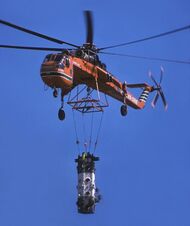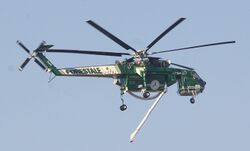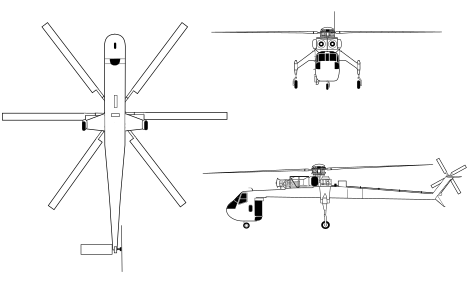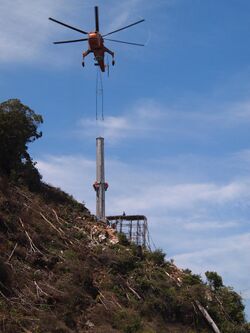Engineering:Sikorsky S-64 Skycrane
| S-64 Skycrane / Aircrane | |
|---|---|
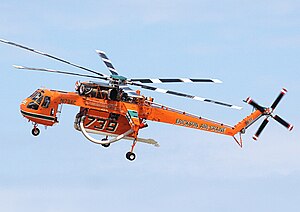
| |
| Erickson S-64 over EAA AirVenture Oshkosh 2009 | |
| Role | Aerial crane |
| National origin | United States |
| Manufacturer | Sikorsky Aircraft Erickson Inc. |
| First flight | 9 May 1962 |
| Status | In service |
| Primary user | Erickson Inc. |
| Number built | 100 |
| Developed from | Sikorsky CH-54 Tarhe |
The Sikorsky S-64 Skycrane is an American twin-engine heavy-lift helicopter. It is the civil version of the United States Army's CH-54 Tarhe. It is currently produced as the S-64 Aircrane by Erickson Inc.
Development
Under Sikorsky
The Sikorsky S-64 was designed as an enlarged version of the prototype flying crane helicopter, the Sikorsky S-60. The S-64 had a six-blade main rotor and was powered by two 4,050 shaft horsepower (3,020 kW) Pratt & Whitney JFTD12A turboshaft engines. The prototype S-64 first flew on 9 May 1962 and was followed by two further examples for evaluation by the German armed forces.[1] The Germans did not place an order, but the United States Army placed an initial order for six S-64A helicopters (with the designation YCH-54A Tarhe). Seven S-64E variants were built by Sikorsky for the civil market.
Under Erickson
Originally a Sikorsky Aircraft product, the type certificate and manufacturing rights were purchased from them by Erickson Air-Crane in 1992. Since that time, Erickson Air-Crane has become the manufacturer and world's largest operator of S-64 Aircranes and has made over 1,350 changes to the airframe, instrumentation, and payload capabilities of the helicopter. The Aircrane can be fitted with a 2,650 US gal (10,000 L) fixed retardant tank to assist in the control of bush fires, and it has proven itself admirably in this role.[2] The helicopter is capable of refilling its entire tank of water in 45 seconds from a water slide 18 in (46 cm) thick.[3]
S-64 Aircranes have been sold to the Italian and Korean Forest Services for fire suppression and emergency response duties. Those in the Erickson Air-Crane fleet are leased worldwide to organizations, companies, and federal government agencies for either short-term or longer term use in fire suppression, civil protection, heavy lift construction, and timber harvesting. Erickson is manufacturing new S-64s, as well as remanufacturing existing CH-54s.
Erickson gives each of its S-64s an individual name, the best-known being "Elvis", used in fighting fires in Australia alongside "The Incredible Hulk" and "Isabelle". Other operators, such as Siller Brothers, have followed with their Sikorsky S-64E, Andy's Pride. The Erickson S-64E nicknamed "Olga" was used to lift the top section of the CN Tower into place in Toronto, Ontario, Canada.[4]
Variants
Sikorsky Skycrane
- S-64
- Twin-engined heavy-lift helicopter, 3 built. 1 rebuilt as S-64E.
- S-64A
- Six test and evaluation helicopters for the US Army.
- S-64B
- Civil version of CH-54A, 7 built.
Erickson
- S-64E
- Upgraded CH-54A helicopters, plus one new build aircraft; 17 aircraft in total.
- S-64F
- Upgraded CH-54B helicopters; powered by two Pratt & Whitney JFTD12-5A engines; 13 aircraft in total.
- S-64F+
- Proposed upgraded version with new engines, avionics, and optional piloting.[5]
Operators
 Italy
Italy
- Corpo Nazionale dei Vigili del Fuoco
 South Korea
South Korea
- Korea Forest Service (6 in service)[6]
 United States
United States
- Columbia Helicopters (no longer in use)[7]
- Erickson Air-Crane[8]
- Evergreen Helicopters, Inc. (bought by Erickson Air-Crane)[9]
- Helicopter Transport Services[10]
- Los Angeles City Fire Department (contracted by Erickson Air-Crane)[11]
- Los Angeles County Fire Department (contracted by Erickson Air-Crane)[12]
- San Diego Gas and Electric (contracted by Erickson Air-Crane)[13]
- Siller Helicopters[14]
Incidents
- N189AC "Gypsy Lady" – crashed in Ojai, California on 1 October 2006. While operating for the USFS, the Erickson S-64 snagged a dip tank and the helicopter rolled over and crashed.[15]
- N198AC "Shirley Jean" – S-64F; sold to European Air-Crane c.2006 as I-SEAD; crashed in Italy on 2007-04-26.[16] Aircraft was destroyed in a post-crash fire.[17]
- N248AC "Aurora" – S-64E; named after Aurora State Airport, home to Columbia Helicopters, former owner of aircraft.[7] Crashed on 26 August 2004 in Corsica, killing its Canadian pilot and French co-pilot. The aircrane was chartered by the interior ministry to fight fires on the French Mediterranean island of Corsica. It had been fighting a wildfire as it went down near the village of Ventiseri, trying to return to a nearby military base, due to technical problems associated with inflight breakup.[18][19]
- N173AC "Christine" – S-64E; ditched into a small dam within Melbourne's water catchment with no casualties during a firefighting operation in Gippsland, Victoria, Australia on 28 January 2019. The crew, consisting of 2 pilots and the flight engineer, were able to bail from the aircraft in 2-3m of water and swim to safety with no life-threatening injuries.[20] The aircraft was rebuilt at Erickson's Central Point, Oregon facility and flew again in early 2021.
- N4037S - An S-64E operated by Siller Helicopters sustained damage to the right main landing gear wheel and tire assembly after a midair collision with a Bell 407 near Cabazon, California while both aircraft were responding to a reported fire on 6 August 2023. The S-64 landed near the collision site with no injuries to the two pilots on board. The Bell 407 sustained substantial damage in the collision, leaving a debris field approximately 1000 feet in length before coming to rest on a rocky hillside where it was consumed by a post-crash fire. The contract pilot along with a Cal Fire Assistant Chief and Cal Fire Captain on board the Bell 407 were killed. [21]
Specifications (S-64E)
Data from The International Directory of Civil Aircraft[22]
General characteristics
- Crew: 3 (pilot, co-pilot), plus one rear-facing aft-stick operator during external-load operations[lower-alpha 1]
- Capacity: up to 5 total people[lower-alpha 2] / 20,000 lb (9,100 kg) payload
- Length: 70 ft 3 in (21.41 m)
- Height: 18 ft 7 in (5.66 m)
- Empty weight: 19,234 lb (8,724 kg)
- Max takeoff weight: 42,000 lb (19,051 kg)
- Powerplant: 2 × Pratt & Whitney JFTD12-4A (T73-P-1) turboshaft engines, 4,500 shp (3,400 kW) each
- Main rotor diameter: 72 ft 0 in (21.95 m)
- Main rotor area: 4,070 sq ft (378 m2)
Performance
- Maximum speed: 109 kn (125 mph, 202 km/h)
- Cruise speed: 91 kn (105 mph, 169 km/h)
- Range: 200 nmi (230 mi, 370 km) max fuel and reserves
- Hover ceiling IGE S-64E: 10,600 ft (3,200 m)
- Hover ceiling IGE S-64A: 9,700 ft (3,000 m)
- Rate of climb: 1,330 ft/min (6.8 m/s)
See also
- Aerial firefighting
- Kaman K-MAX
Related development
- Sikorsky CH-53 Sea Stallion
- Sikorsky CH-54 Tarhe
- Sikorsky S-60
Aircraft of comparable role, configuration and era
Related lists
- List of active United States military aircraft
- List of military aircraft of the United States
- List of rotorcraft
- List of surviving Sikorsky CH-54s
Notes
- ↑ The minimum crew is two and the aft-stick operation can be done by the co-pilot
- ↑ The helicopter has five seats but the two observer seats can not be used during external load operations, if the aft-stick seat is used when not used for external-load operations then the controls have to be disengaged and guarded.
References
- ↑ Jackson, Paul (1976). German Military Aviation 1956–1976. Midland Counties Publications. ISBN 0-904597-03-2.
- ↑ Mason, Ryan (20 October 2021). "Erickson S-64 Air Crane to Return to Australian Skies This Season". https://aerialfiremag.com/2021/10/20/erickson-s-64-air-crane-to-return-to-australian-skies-this-season/.
- ↑ "Firefighting Services". https://ericksoninc.com/services/commercial/fire-fighting/.
- ↑ "Topping of Tower". https://www.cntower.ca/en-ca/about-us/history/topping-of-tower.html.
- ↑ Reim, Garrett (29 January 2020). "Erickson to demo S-64 Air Crane flying autonomously using Sikorsky Matrix". FlightGlobal.com. https://www.flightglobal.com/hai-heli-expo-2020/erickson-to-demo-s-64-air-crane-flying-autonomously-using-sikorsky-matrix/136433.article.
- ↑ "Erickson delivers another Air Crane to Korea Forest Service". fireaviation.com. 2019. https://fireaviation.com/2019/12/23/erickson-delivers-another-air-crane-to-korea-forest-service/.
- ↑ 7.0 7.1 "Helispot photo". Helispot. http://www.helispot.com/qqq/photo/02211.
- ↑ "the origins of Erickson Air-Crane". Erickson Air-Crane, Inc. 2013. http://www.ericksonaircrane.com/history.php.
- ↑ "Evergreen S-64 spec. sheet". Evergreen aviation. http://www.evergreenaviation.com/ehi/specsheets/Skycrane_spec.pdf.
- ↑ "HTS Fleet". htshelicopters.com. http://htshelicopters.com/aircraft/.
- ↑ "LAFD S-64". emergencyrigs.net. http://www.emergencyrigs.net/viewphoto.asp?PhotoID=4546&Size=L.
- ↑ "L.A. County S-64". Yahoo. https://finance.yahoo.com/news/erickson-air-crane-announces-contract-123000553.html;_ylt=A0SO8zLM_XtTJXwA7OZXNyoA;_ylu=X3oDMTEzMjJzbnR2BHNlYwNzcgRwb3MDNwRjb2xvA2dxMQR2dGlkA1ZJUDM2MF8x.
- ↑ "Erickson Air-Crane buys Sun Bird aircraft from San Diego Gas & Electric". Helihub. 7 October 2012. http://helihub.com/2012/10/07/erickson-air-crane-buys-sun-bird-aircraft-from-san-diego-gas-electric/.
- ↑ "Fleet". Siller helicopters. http://sillerhelicopters.com/sikorski-aircraft.php.
- ↑ "NTSB report (LAX07TA001)". Ntsb.gov. https://www.ntsb.gov/_layouts/ntsb.aviation/brief2.aspx?ev_id=20061006X01477&ntsbno=LAX07TA001&akey=1.
- ↑ "Helicopters area of dgualdo.it (report excerpts in Italian)". Archived from the original on 28 September 2007. https://web.archive.org/web/20070928175146/http://www.dgualdo.it/isead-report.htm.
- ↑ "NTSB report – NYC07WA152". Ntsb.gov. 26 April 2007. https://www.ntsb.gov/ntsb/brief.asp?ev_id=20070806X01110&key=1.
- ↑ "NTSB report – WAS04WA012". Ntsb.gov. 26 August 2004. https://www.ntsb.gov/ntsb/brief.asp?ev_id=20041028X01713&key=1.
- ↑ "NTSB probes Air-Crane crash – September 9, 2004". Archive.mailtribune.com. 9 September 2004. http://archive.mailtribune.com/archive/2004/0909/local/stories/09local.htm.
- ↑ "Aircrane extracted after crashing into lake in Australia". fireaviation.com. https://fireaviation.com/2019/05/01/air-crane-extracted-after-crashing-into-lake-in-australia/.
- ↑ "NTSB Report - WPR23FA302". ntsb.gov. https://data.ntsb.gov/carol-repgen/api/Aviation/ReportMain/GenerateNewestReport/192807/pdf.
- ↑ Frawley, Gerard: The International Directiory of Civil Aircraft, 2003–2004, page 195. Aerospace Publications Pty Ltd, 2003. ISBN:1-875671-58-7
External links
- Erickson Air-Crane website
- Canadian Air-Crane website
- Air Tanker Listing
- FAA Type Certificate Data Sheet
- CN Tower antenna being lifted into place – footage 1975
 |
